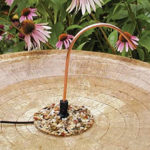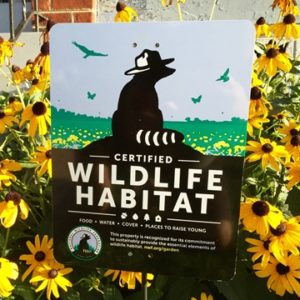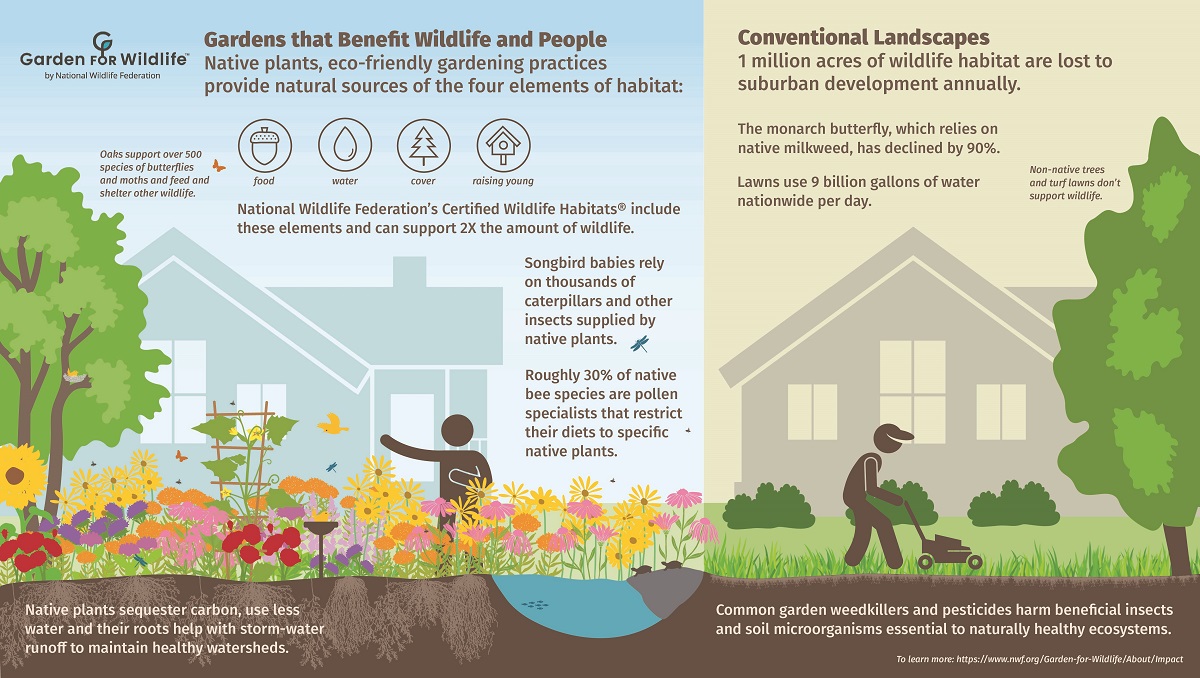All In The Family
Our backyards are a place to relax, eat, socialize, and spend time with family. Why not offer a place for wildlife to do the same? With continued development and loss of Florida’s natural areas, it’s never been more important to nurture birds, pollinators, and other species anywhere we can. Small tweaks that support the basic needs of wildlife and provide peace and quiet, can transform your yard into a beautiful oasis for your family and the wildlife families that live around you.

Food, water, cover and space are all essential for wildlife to thrive. In typical subdivisions, much of the original natural vegetation was removed to make way for homes and replaced with sparse suburban landscaping. You can transform your yard from a ho-hum lawn to a living landscape that attracts wildlife.
Cost: Free or Variable
One of the best ways to support native Florida wildlife in your yard is by adding native plants that provide shelter and food. Want more Butterflies, Birds, or Pollinators? There’s a Florida native plant for that! On the flipside, review these mugshots of common invasive plants, and if you recognize any in your yard, consider removing them as you transition your yard to native plants.
Caring for your existing trees, especially mangroves, and maintaining natural vegetated shorelines on ponds and bayfronts greatly enhances backyard wildlife watching.
Creating layers or varying the height of vegetation adds more area for feeding, hiding, and raising young. Leaving dead trees or brush piles in place, where safely possible, also provides habitat for birds to perch or nest. Plants that produce seeds, nuts, fruit, edible foliage, and flowers can provide food for a variety of wildlife, and for bugs and critters that are eaten by wildlife. Plus, since native landscapes tend to need less care once established, you save on water, fertilizer, pesticides, and energy bills.
WATCH: Gardening For Birds with Laurel and Annie Schiller at Florida Native Plants Nursery.
Did you know? Florida has over 320 bee species, including 29 found nowhere else in the world! Unlike the non-native honeybees that live in hives, most Florida native bees live solitary lives and are threatened by loss of habitat. Learn More about gardening to help native bees.
 Wildlife require water for drinking and bathing. Provide a clean water source such as a rain garden or bird bath. Ideally, the water container should be flat with a gentle slope and no more than two inches deep. Add a stone to the center of the bath as a perch and locate it in an area where birds can scan for predators before approaching, such as near a tree or fence. Refresh the water daily to keep it clean.
Wildlife require water for drinking and bathing. Provide a clean water source such as a rain garden or bird bath. Ideally, the water container should be flat with a gentle slope and no more than two inches deep. Add a stone to the center of the bath as a perch and locate it in an area where birds can scan for predators before approaching, such as near a tree or fence. Refresh the water daily to keep it clean.
Pro-Tip: Moving water attracts more birds, so add a circulating pump or a dripper.
For some species, natural cavities for nesting and resting are usually in shorter supply than food or water. Manmade boxes built to the right size, shape, and color can help support birds, owls, or bats in your yard.
Bats can be a beneficial addition to the wildlife community in your yard because they eat insects—lots of them! Step-by-Step Guide and plans to building and locating a BatBnB or you can buy one built to the right size and color specs.
Owls like the Eastern Screech-Owl, Barn Owl, and Barred Owl may make their home in your yard if you provide a suitable nesting site. Step-by-step Guide to attracting owls and keeping them safe. Each owl species has their own design preferences. Build the right box for the right owl or buy an owl box with the right size specs.
Bird species that nest in cavities have fairly specific preferences for habitats and nestbox dimensions, though not all of Florida’s 25 cavity-nesting bird species will readily use a bird house. Step-by-Step Guide to selecting and building the right house for the right bird, or buy one built to the right specs for the type of bird you want to host.
Cost: Free or Variable
Wildlife has evolved and adapted to regular light and dark cycles that coincide with the days and seasons. Almost 70% of mammals are nocturnal, and that count is rising as animals try to avoid human contact by working the night shift. Artificial light disrupts these cycles and can alter wildlife behavior—attracting or repelling certain animals, changing sleep patterns, and affecting reproductive cycles. Learn more about how artificial light impacts specific groups of animals.
When outdoor light is necessary:
Many wildlife species rely on sound to communicate, find mates, detect predators, protect young, and find food. Constant human noise interferes with these processes and can reduce the survival and health of our local wildlife with symptoms resembling PTSD.
Reduce your backyard noise:
If a household chemical is harmful for you to touch or swallow, it’s likely harmful to wildlife. Herbicides, pesticides, and outdoor cleaners can persist in the environment and directly or indirectly harm wildlife. In particular, rat poison kills slowly, so rodents (or any animal that eats the poison) keep eating long after they’ve ingested a lethal dose. The poisoned rat stumbles around for a few days, making it easy prey for all manner of birds and mammals—and pets—who then suffer secondary poisoning. Learn more about poisons and their non-toxic alternatives, like providing barn owl nesting boxes to let the owls do the job!

The Florida Backyard Landscapes for Wildlife Program will help you landscape your property to be more appealing to birds and other wildlife. Upon completion, you will receive a personalized certificate and yard sign in recognition of your efforts to provide food and cover for wildlife.
If your wildlife friendly yard passes this checklist, you’re ready to have your yard designated a Nationally Certified Wildlife Habitat and a haven for local wildlife.

If you have a passion for plants, your expertise could assist local residents with their gardening questions. Master Gardener volunteers are vital in supporting many UF/IFAS Extension Programs around the state.
Protect natural Florida and promote the use of native plants on home landscapes by joining a local chapter of the Florida Native Plant Society. Serenoa Chapter and Mangrove Chapter.
Join in nighttime celestial viewing events around Sarasota and Manatee counties. Learn about the sources of light pollution and how it washes out our night sky.
Take the Florida-Friendly Landscaping™ Pledge.
Find out what’s happening and join in with our comprehensive community events listing.
Look for these classes
The saying, “you can’t pick your neighbors,” sometimes extends to wildlife as well. Food is food and may attract an unintended guest or a predator of your beloved backyard birds. The good news is that the presence of predators means you’ve created a healthy food web. The occasional visit by a raccoon, bear, or coyote is ok, but if they are coming around regularly, you may need to better secure whatever is attracting them. For example, bird feeders should not be close to the ground or attached to anything that provides easy access to uninvited animals. Harvesting garden foods as soon as they are ripe or using scare tactics like motion sensor lights can help deter unwanted wildlife. If nothing seems to work and you continue to have a visitor who could cause property damage or become a public safety hazard, there are options for live trapping and removal. Read more on the Wondering About Wildife blog series or check out the online Neighborhood Best Practices courses about wildlife.
Your pets are not part of Florida’s natural ecosystem. Even though you may see your dog or cat as well behaved and harmless, many kinds of wildlife can be put at risk if an overly friendly dog or curious cat goes scampering off without any restraint. For example, unleashed dogs chasing nesting shorebirds can trample young chicks or cause parents to abandon their nests. According to the Florida Fish and Wildlife Conservation Commission, “A single individual free-ranging cat may kill 100 or more birds and mammals per year.” Outdoor cats are also the primary host for transmitting toxoplasmosis to wildlife, a disease which has killed manatees and other mammals. Plus, waste deposited by free-ranging pets is not only harmful to wildlife and people, but it can degrade our water quality. Read more on reducing feral and domestic cat and wildlife interactions.
Submit your Nature-related question to local experts. If selected, they will answer and feature your question on our FAQ. Not all questions will be answered.
This site protected by reCAPTCHA and the Google Privacy Policy and Term of Service apply.
©2025 Science and Environment Council of Southwest Florida | Site by Chariot.